Sd.Kfz.251/9
Ausf. C and Ausf. D
mittlerer Schützenpanzerwagen (7.5cm Kanone)
"Kanonenwagen"
A Compare & Contrast Review In 1/72 scale
 vs
vs 
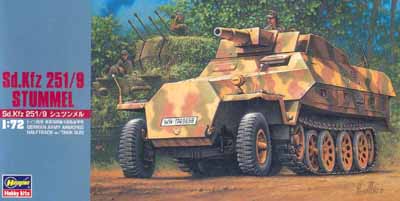
1. Introduction
This particular review article covers modeling the Sd.Kfz.251/9
support halftrack in 1/72 scale. My goal in this article is the
comparison of the Hasegawa versus the Dragon
Sd.Kfz. 251 models and the study and assembly of the Sd.Kfz
251/9 vehicle in 1/72 scale. Model kits I chose were the Hasegawa
model MT-46 late-version Sd.Kfz. 251/9 kit assembled with the
help of etched brass frets from Part; and a conversion of the Dragon
kit #7223 Sd.Kfz. 251/1 Ausf C, to an early version 251/9. My intentions
for years have been to use ESCI’s old 251 Ausf. C kit as the
basis for a 251/9 conversion; however the Dragon [DML] kit is so
much superior over ESCI's that it gives us the capability of a much
better model with less effort. There will already be considerable
effort converting it from a 251/1 to a 251/9. Dragon’s Ausf.
C and Ausf. D kits share many of the same parts so this review will
also reflect Dragon’s
Ausf. D kit.
Around the year 2000 Hasegawa released their model of the Sd.Kfz
251/9 Ausf. D halftrack model which I greeted with great thrill.
Not only was the Hasegawa kit a great improvement in quality &
detail over the earlier ESCI Sd.Kfz. 251 halftrack, but it was also
a model of the later model D [Ausf. D]. The Hasegawa vehicle was
also offered in versions not offered by ESCI [now Italeri]: the
Sd.Kfz. 251/9 Stummel and the Sd.Kfz.
251/22 Pakwagen. Make note that the nicknames ‘Stummel’
and also ‘Pakwagen’ were not official vehicle titles,
though I will use the term Stummel here as this is the vehicle’s
commonly used nickname.
Mounting a short 75-mm cannon (Kanone), the Stummel provided valuable
support for the German Panzergrenadiers. There were two basic versions;
the first based on the Sd.Kfz. 251 Ausf. C (and early Ausf. D) which
had the Sturmgeschütz’s 7.5-cm Kanone 37 L/24 gun mounted
low in the superstructure on a pedestal supported on the halftrack’s
frame, with the gun protruding through the front driver’s
plate. [This is the version that is the subject of the Dragon conversion.]
This version saw combat after April 1943 though test vehicles were
available as early as June 1942.
The later version of the 251/9 and the subject of the Hasegawa model
MT-46 was developed with the purpose-built 7.5-cm Kanone 51 that
was installed atop the roof over the driver and was a more simple
conversion of the 251 Ausf. D. For more detailed information on
these vehicles I refer you to the references listed below. This
is the same mount as in the Sd.Kfz 234/3 8-Rad armored car.
2. The Parts
Both Dragon’s and Hasegawa’s Sd.Kfz 251 have their parts
and sprues covered in other articles, so I will try and focus on
features particular to the 251/9, shown and discussed below.
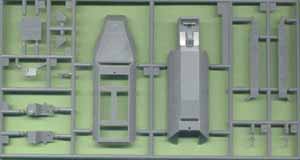
Here we have the Hasegawa sprue for
the upper and lower body of the Sd.Kfz 251 Ausf. D, common to all
three of Hasegawa’s 251 kits. The side storage bins at upper
right (parts A1 & A2) can be replaced by Part’s etched
brass parts and therefore modeled open. The rear doors (part A10)
are modeled closed but can be easily separated so as to be modeled
open.
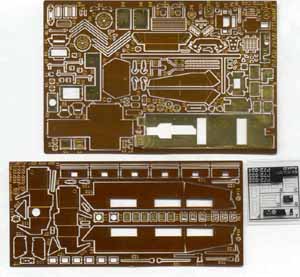
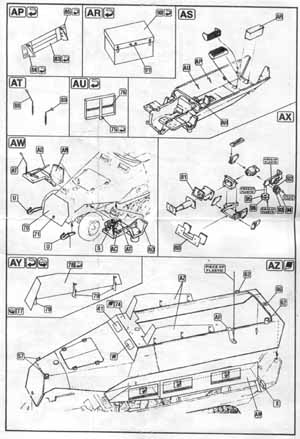
Part’s etched
brass frets for this Hasegawa’s model. The replacement
front fenders were difficult to shape and fit properly but overall
this set offers some excellent upgrades to Hasegawa’s plastic
parts. The clear sheet at lower right has a replacement instrument
panel and viewport windows. The brass fret at the top is particular
to the 251/9 with brass side armor, ammunition storage box, and
details for the Kanone 51 gun as shown in part AX of Part’s
instructions.
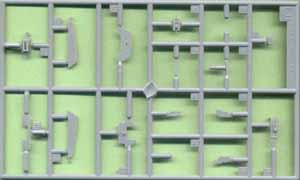
Hasegawa offers a new Sprue J just for this model in light gray
styrene plastic that includes the basic parts for the side armor
and basic 7.5-cm Kanone 51 gun. The shield parts are too thick for
1/72 scale, and the gun lacks the elevation and traverse handwheels
and the gunsight. This is the same sprue in Hasegawa’s Sd.Kfz.
234/3 armored car kit.
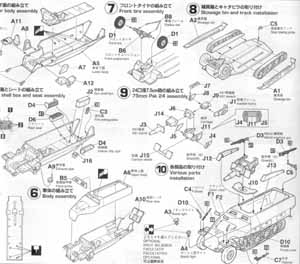
Hasegawa’s instructions for their 251/9, a variation from
their basic 251/1 troop carrier instructions. Note the assembly
of the main gun, mounted atop the driver’s roof. Part’s
brass fret supplies some needed elevation & traverse parts but
no gunsight.
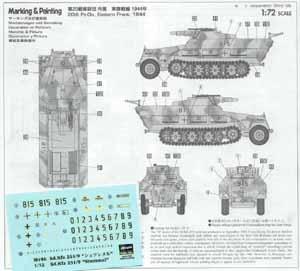
This is Hasegawa’s painting & decal guide. Though not
in Dragon’s glossy full color spread, this is fully adequate
for the job. The decals applied well on the finished model over
a glosscoat of acrylic floor wax, then finished with Model Master’s
acrylic dullcoat. It’s interesting in that Hasegawa offers
a ‘build your own’ license plate system similar to that
offered by Dragon.
3. The Dragon Conversion:
251/9 Ausf C early Stummel
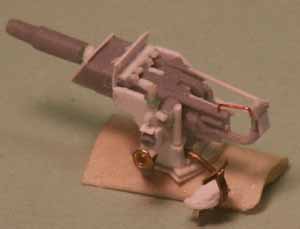
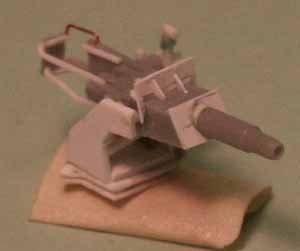
Conversion of Hasegawa’s Kanone 51 gun to the earlier 7.5-cm.Kanone
37 gun took some careful thought, studying, scratchbuilding and
dry-fitting of the parts. References for the early Kanone 37 mounted
in the 251 are few and far in between. The new gun base and cradle
were patterned after parts from Roden’s Sd.Kfz 234 kit and
the museum photo references. Parts were cut, fit, sanded and filed
and refit till they looked right.
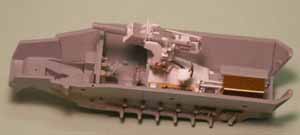
For the conversion to the early Sd.Kfz. 251/9 based on the 251
Ausf. C, the Hasegawa sprue J [shown above] can be used but must
be considerably modified to represent the earlier 7.5-cm Kanone
37 gun that had been mounted on the floor of the Sturmgeschütz.
We can also use and modify the sprue from Italeri’s Sd.Kfz.
234/3 armored car model. Another option for the 251/9 Ausf. C conversion
is the gun from Roden’s Sd.Kfz. 233 kit, which has the same
Kanone 37 gun and mount as this 251/9 Ausf. C halftrack, though
it still needs some detailing to improve.
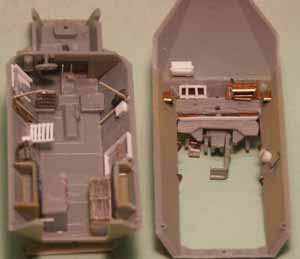
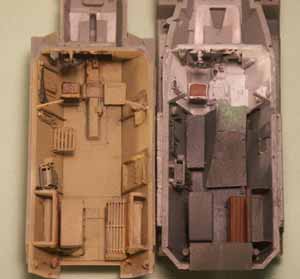
These two photos exhibit the differences between the initial
version of the Sd.Kfz. 251/9 with the floor mounted weapon and the
later version with the weapon mounted on the roof. The early Kanone
37 gun mounting was used with the Ausf. C hull and some Ausf. D
hulls. The later version Kanone 51 was all on the Ausf. D hull.
The Ausf. C interior was finished in 1942 period gray paint with
a white (actually ivory) driver’s compartment forward of the
flange connecting the hull sections. When I completed this Sd.Kfz.
251/9 Ausf. C, I understood that this halftrack's driver's area
was painted white; it just made sense to me and matched several
period photos I have. Recently, well, after completing this model,
I was informed that this white driver's area was true for the 251
Ausf. A and B and some early Ausf. C halftracks; but most 251 Ausf.
C had the driver's area painted the same dark gray as the rest of
the exterior and interior. After further studying period photos
I now also agree that this is the case! The period photos I based
my colors on I know believe are of Sd.Kfz. 251 Ausf. A or B which
did have an ivory driver's area. The 251 Ausf. D’s interior
was completed in overall Dunkelgelb, same as on the exterior.
In this view we can see the interior details such as the flanges
just behind the driver’s seat, ammunition storage, and crew
seating. Note the location of the radios at the left center, moved
from the right front due to the location of the main gun. In the
gray colored 251/9 Ausf. C at far right you may be able to discern
the scratchbuilt pedestal mount.
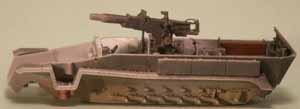
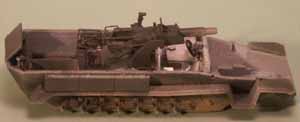
The photos above of the Ausf. C with the Kanone 37 gun version can
be compared with the late 251/9 Ausf. D in the photos below. The
roof mount of the Kanone 51 gun freed some space in the crew compartment
and allowed the vehicle to be more easily converted, though was
higher in profile.
4. The Hasegawa 251/9 Ausf.
D late Stummel model
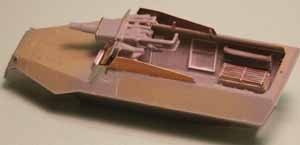
View of the right interior of the
partially assembled Hasegawa 251/9 Ausf. D kit with the crew seat
and ammunition ready-rack, but prior to detailing of the 7.5-cm
Kanone 51 gun. This Hasegawa kit shows the Part aftermarket brass
and the right side’s scratchbuilt ammunition ready-rack [the
Part brass part #75 is too large].
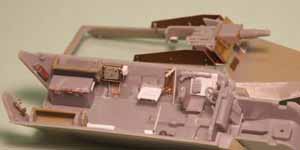
This photo shows the left interior
of the Hasegawa model with considerable detailing thanks to Part
etched brass and spare DML parts and sheet styrene. Items like the
ammunition bin latches were made from thin wire. The entire interior
was later painted in Panzer yellow, the same base color as the exterior.
5. Painting & Completion
of the two Sd.Kfz. 251/9 Models in 1/72
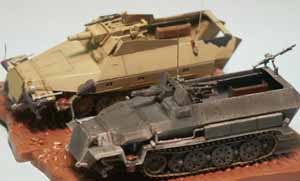
The two mostly completed Sd.Kfz. 251/9 models in 1/72 scale, still
waiting on final painting, front wheels, decal markings final weathering.
Both compare well in width and length. This is a good opportunity
to examine the differences between the early 251/9 on the Ausf.
C body [in gray color] and the late 251/9 on the Ausf. D body [in
panzer yellow]. The early gun of the Ausf. C version sits lower,
protruding through the front next to the driver’s visor. The
bases are from old Matchbox 1/76-scale AFV models with diorama bases.
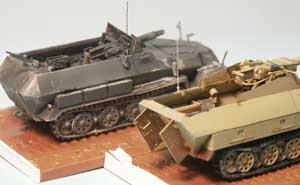
The rear ¾ view of the two
almost-complete models. From here we can see the changes between
the Ausf. C at left, and the Ausf. D at right; such as the change
in the rear doors and the storage bins. The Hasegawa model at right
has been upgraded with etched brass, open rear doors.
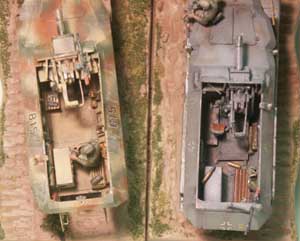
Ta Daaaaa…! Overhead view of
the two models. I am pleased to have received a gold medal for the
early Sd.Kfz. 251/9 Ausf. C (at right) at the AMPS East Contest
this past autumn 2008. Ammunition rounds and storage tubes are from
Attack Models resin Ammunition
Set No. 2 (Item #72322). The markings are water-slide decals
included in the model kits, except for the license numbers on both
models. Dragon’s and Hasegawa’s license plates comprise
a white rectangle and separate individual numbers and letters; this
effort takes the patience of a saint to put together and get the
numbers all straight and so were not used (I am not a saint no matter
what my family thinks). The markings were applied over an acrylic
gloss coat and then sealed in Model Master dullcoat. Hasegawa’s
model represents a vehicle of the 8th Company of the 2nd Battalion,
Panzergrenadier Regiment 59 of the 20th Panzer Division on the Ostfront,
in a 3-color camouflage scheme. The Dragon model represents an early
Sd.Kfz. 251/9 Ausf. C of the 9th Panzer Division of Heeresgruppe
Mitte (Army Group Center), Ostfront.
After the base paint color an oil pin-wash was used in recesses
and only then a light clear dullcoat applied. Weathering was completed
with a light dusting of thinned earth color acrylic paint on lower
areas, then with powdered pastels and pigment powder. A Graphite
pencil was used to represent wear of the paint on edges and corners.
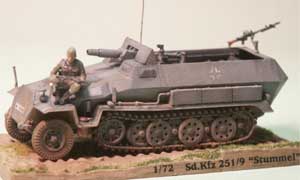
Dragon Sd.Kfz. 251/9 Ausf.
C Conversion, a Sd.Kfz. 251/9 Ausf C of the 9th Panzer Division
of Heeresgruppe Mitte (Army Group Center), Ostfront.
6. Conclusions
Both kits build into a decent display model especially with some
etched brass details. Reflecting newer molding technology the newer
Dragon model comes with more and more finally detailed parts. Hasegawa’s
tracks strike me as too thick and nothing detracts from an AFV model
like poor tracks. If I were a wargamer I would go with the Hasegawa
or ESCI kits; for a display model I recommend the Dragon model.
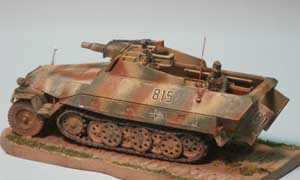
A vehicle of the
8th Company of the 2nd Battalion, Panzergrenadier Regiment 59 of
the 20th Panzer Division on the Ostfront, in a 3-color camouflage
scheme.
References
PANZER TRACTS No 15-3 mittlerer Schuetzenpanzerwagen Ausf. C &
D, By Thomas Jentz & Hilary Doyle. A superb softcover on the
production, variants, organization and employment history of the
Sd.Kfz. 251 from 1943 to 1945. With scale drawings and sharp black
& white photos. The Panzer Tracts books are probably the most
accurate English language source for information on German WW2 vehicles.
Highly recommended for the modeler and historian.
PANZER TRACTS No 15-2 mittlerer Schuetzenpanzerwagen
Ausf. A to C, 1939 to 1942 , by Thomas Jentz & Hilary Doyle.
This is a companion book to Panzer Tracts No. 15-3, and both books
expand on and have replaced Panzer Tracts No. 15.
http://www.pietvanhees.nl/251/
The (HANOMAG) Sd. Kfz. 251 website, by Piet van Hees (formerly located
at http://www.geocities.com/MotorCity/Pit/3515/251/index.htm). This
excellent website is dedicated to the Sd.Kfz. 251 halftrack. [According
to Jentz & Doyle, ‘Hanomag’ was never an official
or slang term for the 251, but apparently is a post war term based
on one of the many manufacturers of this vehicle.]
Sd.Kfz 251 In Action, Squadron/Signal
Armor No. 21, by Charles Kliment & Don Greer (1981). An old
book with some old disproved information, but inexpensive and containing
great photos, color plates and sketches. Very recommended.
SCHUTZENPANZERWAGEN War Horse of
the Panzer Grenadiers, by Horst Scheibert (1992), Schiffer Military
History. An inexpensive softcover with period photos and coverage
of the Sd.Kfz 251 and its smaller cousin the Sd.Kfz. 250.
ATTACK HOBBY KITS, Herrmannova 4,
77900 Olomouc, Czech Republic. Source for assorted ammunition sets
cast in resin. FAX: +420585228419; attack.hobby.kits(at)tiscali.cz
or attack.hobby.kits(at)volny.cz
NUTS & BOLTS Vol. 06, KANONENWAGEN
(Sd.Kfz 251/9), by Detlev Terlisten. This is a good reference I
used and it focuses on the Stummel but I understand now that it
has been replaced by the even better NUTS & BOLTS No. 21. This
book will also be helpful is detailing the Sd.Kfz. 234/3 armored
car and Sd.Kfz 250/8 light halftrack.
|





















